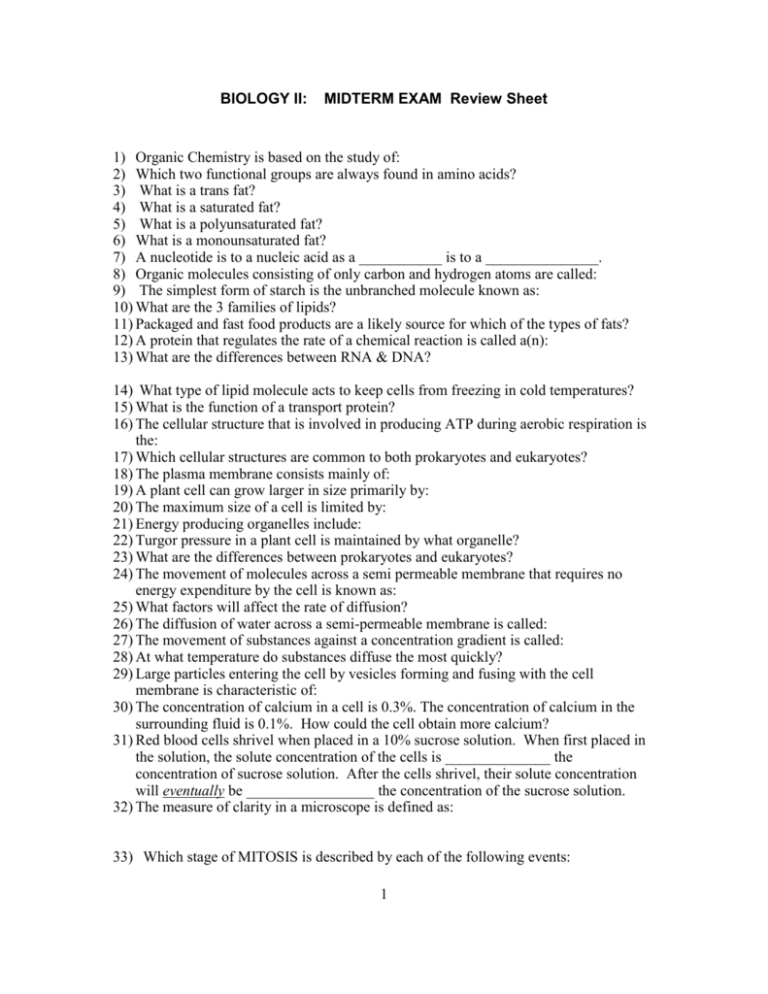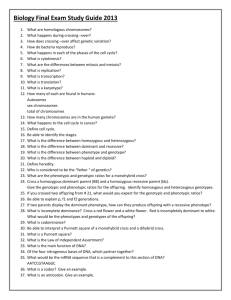MIDTERM EXAM - Parma City School District
advertisement

BIOLOGY II: MIDTERM EXAM Review Sheet 1) Organic Chemistry is based on the study of: 2) Which two functional groups are always found in amino acids? 3) What is a trans fat? 4) What is a saturated fat? 5) What is a polyunsaturated fat? 6) What is a monounsaturated fat? 7) A nucleotide is to a nucleic acid as a ___________ is to a _______________. 8) Organic molecules consisting of only carbon and hydrogen atoms are called: 9) The simplest form of starch is the unbranched molecule known as: 10) What are the 3 families of lipids? 11) Packaged and fast food products are a likely source for which of the types of fats? 12) A protein that regulates the rate of a chemical reaction is called a(n): 13) What are the differences between RNA & DNA? 14) What type of lipid molecule acts to keep cells from freezing in cold temperatures? 15) What is the function of a transport protein? 16) The cellular structure that is involved in producing ATP during aerobic respiration is the: 17) Which cellular structures are common to both prokaryotes and eukaryotes? 18) The plasma membrane consists mainly of: 19) A plant cell can grow larger in size primarily by: 20) The maximum size of a cell is limited by: 21) Energy producing organelles include: 22) Turgor pressure in a plant cell is maintained by what organelle? 23) What are the differences between prokaryotes and eukaryotes? 24) The movement of molecules across a semi permeable membrane that requires no energy expenditure by the cell is known as: 25) What factors will affect the rate of diffusion? 26) The diffusion of water across a semi-permeable membrane is called: 27) The movement of substances against a concentration gradient is called: 28) At what temperature do substances diffuse the most quickly? 29) Large particles entering the cell by vesicles forming and fusing with the cell membrane is characteristic of: 30) The concentration of calcium in a cell is 0.3%. The concentration of calcium in the surrounding fluid is 0.1%. How could the cell obtain more calcium? 31) Red blood cells shrivel when placed in a 10% sucrose solution. When first placed in the solution, the solute concentration of the cells is ______________ the concentration of sucrose solution. After the cells shrivel, their solute concentration will eventually be _________________ the concentration of the sucrose solution. 32) The measure of clarity in a microscope is defined as: 33) Which stage of MITOSIS is described by each of the following events: 1 34) DNA Replication occurs 35) Centrioles begin to move apart in animal cells 36) Centromeres uncouple, sister chromatids are separated and each new chromosome moves to opposite poles of the cell. 37) Chromosomes are lined up in the middle of the cell 38) Two distinct nuclei may be visible. 39) The formation of a cell plate is beginning across the middle of a cell and nuclei are forming at opposite ends of the cell. What kind of cell is this? 40) A cell containing 24 chromosomes at the start of mitosis would, at its completion, produce cells containing how many chromosomes? 41) What is the correct sequence of events to describe the cell cycle and mitosis? 42) The restoration of the diploid chromosome number after meiosis is due to: 43) What is a karyotype? 44) Humans have 46 chromosomes. That number of chromosomes will be found in : 45) A human egg cell that contains 22 autosomes and one X chromosome is a(n): 46) If the (n) or haploid number of chromosomes in an organism is 8, how many combined chromosomes would a kidney cell, a sperm cell, and a liver cell have if one were to add the three totaled together? 47) What is binary fission in prokaryotes? 48) A couple, each who is a carrier for the gene that causes cystic fibrosis, have two children who have the disease. What is the probability that their next child will be phenotypically normal? 49) Sickle cell anemia is the result of a single recessive gene in the homozygous state (ss), yet this disease has a complex set of symptoms affecting many parts of the body. Which term is most applicable to this example? 50) In crossing a homozygous recessive with a heterozygote, what is the chance of getting a homozygous recessive phenotype in the F1 generation? 51) In snapdragons, heterozygotes have pink flowers, whereas homozygotes have either red or white flowers. When plants with red flowers are crossed with plants having white flowers, what proportion of the offspring will have pink flowers? 52) A woman and her husband both show the normal phenotype for pigmentation, but both had one parent who was an albino, Albinism is an autosomal recessive trait. 53) What is the probability that their first child will be an albino? 54) If their first two children have normal pigmentation, what is the chance that their third child will be an albino? 55) What is the chance that their fourth child will have a homozygous genotype? 56) a.) 0% b.) 25% c.) 50% d.) 75% e.)100% 57) What is the genetic cross between a homozygous recessive individual and one of an unknown genotype called? 58) Give an example of polygenic inheritance. Define each of the following modes of inheritance 2 59) incomplete dominance 60) multiple alleles 61) pleiotropy 62) epistasis 63) penetrance 64) The particular position of a gene on a chromosome is known as a(n): 65) What increases the frequency of crossing over between any two linked genes? 66) Who is known as the “Father of Genetics” 67) An alternate form of the same gene for a given trait is a(n): 68) How many copies of each chromosome are found in every somatic cell in your body? 69) Having blood type AB is an example of which mode of inheritance? 70) The ABO blood groups, discovered by Dr. Karl Landsteiner, are based on the presence or absence of specific _______________ on the surface of red blood cells. 71) Some people are able to roll their tongues into a U-shape. The ability to do this is inherited as an autosomal dominant allele. What is the probability that children descendent from parents both heterozygous for this trait will be able to form a Ushape with their tongues? 72) Suppose that in sheep, a dominant allele (B) produces black hair and a recessive allele (b) produces white hair. If you saw a black sheep, you would be able to identify its: 73) From which parent(s) did a male with red-green colorblindness inherit the defective allele? 74) A human genetic defect that is caused by nondisjunction of the sex chromosomes is: 75) Jack is homozygous for type A blood. He has a child with Jill, who has type AB blood. What is the percent chance that their first child will have type B blood? 76) A good example of a sex-limited trait would be: 77) Having an extra or a missing chromosome is called: 78) What are some of the widely used genetic screening techniques? 79) Chromosomes are made up of: 80) Which “principle” is Frederick Griffith responsible for: 81) Avery, McCarty, and Mcleod’s experiment showed that transformation could be stopped in bacterial cells by: 82) What are Purines and Pyrimidines? 83) What are the base pairings according to Chargaff’s Rule? 84) What are the differences between RNA and DNA? 85) The process of DNA replication is Semi-conservative, which means: 86) Who is given credit with establishing the fact that the structure of a DNA molecule is actually a double helix? 87) What is the name of the enzyme that unwinds the DNA helix during replication? 88) DNA replication is initiated by the enzyme: 89) What type of mutation results when a sequence of nucleotides gets moved to an entirely different chromosome? 90) In RNA, what base does Uracil replace with respect to DNA? 91) During DNA replication, a complementary strand of DNA is made for each original DNA strand. Thus, if a portion of the original strand is CCTAGCT, then the new strand will be: 92) What type of mutation results when a sequence of nucleotides gets turned around on 3 the same chromosome? 93) Any change in the DNA molecule that may occur during replication is known as a(n): 94) The “One-gene-one-polypeptide” hypothesis states that: 95) How many different codon combinations are there in the genetic code? 96) On what organelle does the translation of proteins occur? 97) A mRNA sequence that expresses a code for a protein is called a(n): 98) Gene expression takes place in two stages. During the first stage an RNA copy of a gene is made. This stage is called: 99) ________________ are complementary to mRNA codons. 100) In the second stage of gene expression, amino acids are assembled to form proteins. This stage is called: 101) Why is the genetic code said to be “universal”? 102) A messenger RNA (mRNA) strand reads: GUUCAAGGC, which of the following would represent the strand of DNA from which the mRNA strand was made? 103) The anticodons for the codons in the above mRNA are: 104) Give the various forms in which RNA occurs: 105) A sequence of DNA that directs a particular biosynthetic pathway is called a(n): 106) The two strands of a DNA molecule are connected by: 107) Which human disorder is characterized by a group of abnormal cells that suddenly begin to undergo cell division at uncontrolled rates? 108) Green plants use carbon dioxide for: 109) Animals that cannot make their own food are called: 110) What is the net gain of ATP in aerobic respiration? 111) What is the net gain of ATP in anaerobic respiration? 112) Which type of microscope would you use if you wanted to get the highest total magnification possible AND you wanted to see only the surface of the specimen? 4









